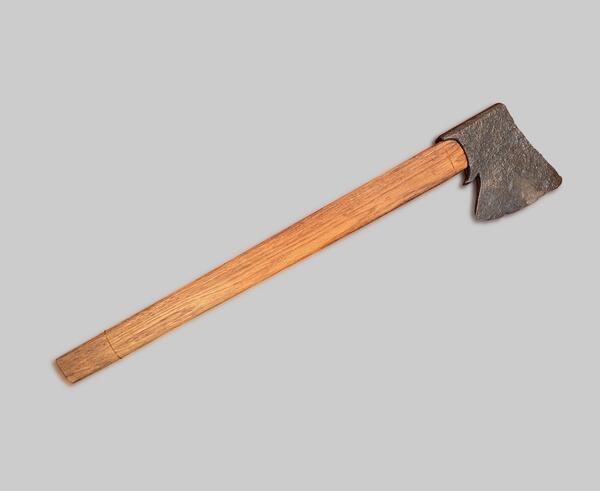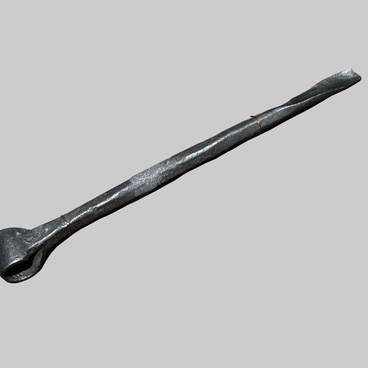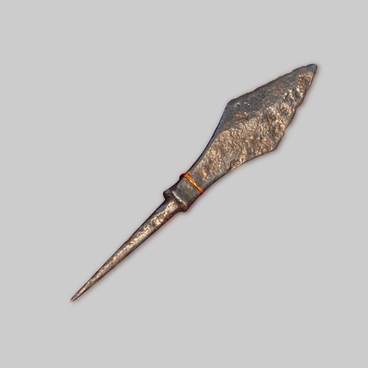Service class people of Kuznetsk ostrog participated in military expeditions and long-distance special duty assignments, pulled duty on the town walls, they were sent out to collect yasak (tribute paid off in furs). But their principal occupation was construction: they built fortifications, dwellings and housekeeping areas. Wood processing tools from the excavations in Kuznetsk ostrog are an important source of information for learning the city history.
The axe in the museum permanent exhibition was used for cutting and hewing. It is an iron shaft-hole axe with an arc-shaped cutting surface. The axe has been restored, i.e. cleared from corrosion and helved.
Traditionally, the axes consisted of three parts – a metal blade, a wooden handle and a wedge to fix the axe on it. The handle could be of various shapes. The longer was the handle, the stronger could be the strike upon sweeping the axe.
The axe handle was driven into a special eye in the blade and then the run-in end was expanded with a wedge. The principal part of the axe is a blade, as the durability and convenience of the tool depended on the blade properties. The axe handle was removable, it could be easily replaced by a beer one when required.
The metal part of the axe was made of hard steel. The edge was tempered applying a special method, to improve its cutting properties. The rest of the blade remained soft thus preventing chipping of the metal due to strong strikes. The axe yielded to the knife on hardness of the cutting edge, that is why it was easier and quicker to sharpen.
From a professional point of view, the axes differ by the blade size – wide, mid-size and narrow, or, to be more correct, by the width of the axe head: wide, mid-size and narrow. Wood cutting axes had a wide head; universal axes had a mid-size head, and a narrow head was typical for the axes of carpenters and for those used for fine work.
The axes are also divided by the length of the handle, the width and shape of the blade. The axes with straight sharpening were designed for making cutting strikes, while the curved sharpening allowed both cutting and chipping.
By their purpose, the axes are classified as universal wood processing tools. They were widely spread among the Siberian population in XVII century. Relevant evidence can be found in the customs books of Siberian cities where in the range of goods imported from Rus there were ‘small, mid-size and large axes’.
A specialist in fabrication technology of the articles made of ferrous metals, Nikolay Maximvch Zinyakov studied the axes found in excavations of Kuznetsk ostrog. The analysis showed that two axes found had been manufactured using different process schemes.
The axe in the museum permanent exhibition was used for cutting and hewing. It is an iron shaft-hole axe with an arc-shaped cutting surface. The axe has been restored, i.e. cleared from corrosion and helved.
Traditionally, the axes consisted of three parts – a metal blade, a wooden handle and a wedge to fix the axe on it. The handle could be of various shapes. The longer was the handle, the stronger could be the strike upon sweeping the axe.
The axe handle was driven into a special eye in the blade and then the run-in end was expanded with a wedge. The principal part of the axe is a blade, as the durability and convenience of the tool depended on the blade properties. The axe handle was removable, it could be easily replaced by a beer one when required.
The metal part of the axe was made of hard steel. The edge was tempered applying a special method, to improve its cutting properties. The rest of the blade remained soft thus preventing chipping of the metal due to strong strikes. The axe yielded to the knife on hardness of the cutting edge, that is why it was easier and quicker to sharpen.
From a professional point of view, the axes differ by the blade size – wide, mid-size and narrow, or, to be more correct, by the width of the axe head: wide, mid-size and narrow. Wood cutting axes had a wide head; universal axes had a mid-size head, and a narrow head was typical for the axes of carpenters and for those used for fine work.
The axes are also divided by the length of the handle, the width and shape of the blade. The axes with straight sharpening were designed for making cutting strikes, while the curved sharpening allowed both cutting and chipping.
By their purpose, the axes are classified as universal wood processing tools. They were widely spread among the Siberian population in XVII century. Relevant evidence can be found in the customs books of Siberian cities where in the range of goods imported from Rus there were ‘small, mid-size and large axes’.
A specialist in fabrication technology of the articles made of ferrous metals, Nikolay Maximvch Zinyakov studied the axes found in excavations of Kuznetsk ostrog. The analysis showed that two axes found had been manufactured using different process schemes.



